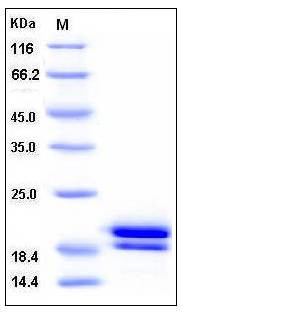Human REG1B / PSPS2 Protein (His Tag)
PSPS2,REGH,REGI-BETA,REGL
- 100ug (NPP4212) Please inquiry
| Catalog Number | P11638-H08H |
|---|---|
| Organism Species | Human |
| Host | Human Cells |
| Synonyms | PSPS2,REGH,REGI-BETA,REGL |
| Molecular Weight | The recombinant human REG1B consists of 155 amino acids and predictes a molecular mass of 17.7 kDa. In SDS-PAGE under reducing conditions, the apparent molecular mass of rh REG1B is approximately 19-21 kDa due to different glycosylation. |
| predicted N | Gln 23 |
| SDS-PAGE |  |
| Purity | > 95 % as determined by SDS-PAGE |
| Protein Construction | A DNA sequence encoding the human REG1B (NP_006498.1) (Met 1-Asn 166) was fused with a polyhistidine tag at the C-terminus. |
| Bio-activity | |
| Research Area | Signaling |Signal Transduction |Cytoskeleton / ECM |Cell Adhesion |Lectin |C-tyep lectin | |
| Formulation | Lyophilized from sterile PBS, pH 7.4 1. Normally 5 % - 8 % trehalose, mannitol and 0.01% Tween80 are added as protectants before lyophilization. Specific concentrations are included in the hardcopy of COA. |
| Background | Regenerating gene (Reg), first isolated from a regenerating islet cDNA library, encodes a secretory protein with a growth stimulating effect on pancreatic beta cells, and could be associated with fibrocalculous pancreatopathy. Reg and Reg-related genes which were expressed in various organs have been revealed to constitute a multigene family, the Reg family consisting of four subtypes (types I, II, III, IV) and are involved in cancers and neurodegenerative diseases. Regenerating islet-derived 1 beta (REG1B), also known as Lithostathine-1-beta and Pancreatic stone protein 2 (PSPS2), is a types I Reg protein and contains one typical C-type lectin domain. REG1B is a 166-amino acid protein which has 22 amino acid substitutions in comparison with the previously isolated human REG1A, and it is was expressed only in pancreas. REG1B Is normally found in the exocrine pancreas, whereas in other tissues it appears either only under pathological conditions, such as Alzheimer's disease (brain), cancer (colon), or during regeneration such as neuronal sprouting in brain and pancreas regeneration. REG1B might act as an inhibitor of spontaneous calcium carbonate precipitation. The REG1A and REG1B gene and proteins could play different roles in the pancreas. |
| Reference |
